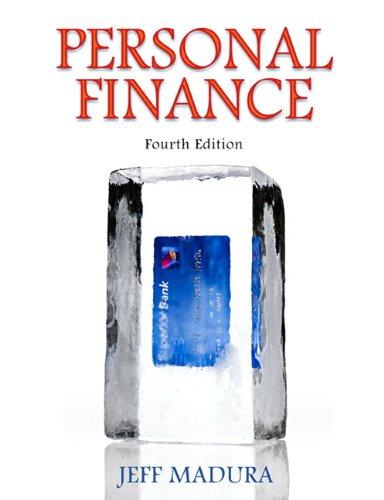Question
formance lg3 lg4 mary and nick ... Question:Case Problem 13.1 Assessing the Stalcheckss Portfolio Performance LG3 LG4 Mary and Nick Stalchec... Case Problem 13.1 Assessing
formance lg3 lg4 mary and nick ...
Question:Case Problem 13.1 Assessing the Stalcheckss Portfolio Performance LG3 LG4 Mary and Nick Stalchec...
Case Problem 13.1 Assessing the Stalcheckss Portfolio Performance LG3 LG4 Mary and Nick Stalcheck have an investment portfolio containing 4 investments. It was developed to provide them with a balance between current income and capital appreciation. Rather than acquire mutual fund shares or diversify within a given class of investments, they developed their portfolio with the idea of diversifying across various asset classes. The portfolio currently contains common stock, industrial bonds, mutual fund shares, and options. They acquired each of these investments during the past 3 years, and they plan to purchase other investments sometime in the future. Currently, the Stalchecks are interested in measuring the return on their investment and assessing how well they have done relative to the market. They hope that the return earned over the past calendar year is in excess of what they would have earned by investing in a portfolio consisting of the S&P 500 Stock Composite Index. Their research has indicated that the risk-free rate was 7.2% and that the (before-tax) return on the S&P 500 portfolio was 10.1% during the past year. With the aid of a friend, they have been able to estimate the beta of their portfolio, which was 1.20. In their analysis, they have planned to ignore taxes because they feel their earnings have been adequately sheltered. Because they did not make any portfolio transactions during the past year, all of the Stalcheckss investments have been held more than 12 months, and they would have to consider only unrealized capital gains, if any. To make the necessary calculations, the Stalchecks have gathered the following information on each investment in their portfolio. Common stock. They own 400 shares of KJ Enterprises common stock. KJ is a diversified manufacturer of metal pipe and is known for its unbroken stream of dividends. Over the past few years, it has entered new markets and, as a result, has offered moderate capital appreciation potential. Its share price has risen from $17.25 at the start of the last calendar year to $18.75 at the end of the year. During the year, quarterly cash dividends of $0.20, $0.20, $0.25, and $0.25 were paid. Industrial bonds. The Stalchecks own 8 Cal Industries bonds. The bonds have a $1,000 par value, have a 9.250% coupon, and are due in 2024. They are A-rated by Moodys. The bonds were quoted at 97.000 at the beginning of the year and ended the calendar year at 96.375%. Mutual fund. The Stalchecks hold 500 shares in the Holt Fund, a balanced, no-load mutual fund. The dividend distributions on the fund during the year consisted of $0.60 in investment income and $0.50 in capital gains. The funds NAV at the beginning of the calendar year was $19.45, and it ended the year at $20.02. Options. The Stalchecks own 100 options contracts on the stock of a company they follow. The value of these contracts totaled $26,000 at the beginning of the calendar year. At year-end the total value of the options contracts was $29,000. Questions a. Calculate the holding period return on a before-tax basis for each of these 4 investments. b. Assuming that the Stalcheckss ordinary income is currently being taxed at a combined (federal and state) tax rate of 38% and that they would pay a 15% capital gains tax on dividends and capital gains for holding periods longer than 12 months, determine the after-tax HPR for each of their 4 investments. c. Recognizing that all gains on the Stalcheckss investments were unrealized, calculate the before-tax portfolio HPR for their 4-investment portfolio during the past calendar year. Evaluate this return relative to its current income and capital gain components. d. Use the HPR calculated in question c to compute Jensens measure (Jensens alpha). Use that measure to analyze the performance of the Stalcheckss portfolio on a risk-adjusted, market-adjusted basis. Comment on your finding. Is it reasonable to use Jensens measure to evaluate a 4-investment portfolio? Why or why not? e. On the basis of your analysis in questions a, c, and d, what, if any, recommendations might you offer the Stalchecks relative to the revision of their portfolio? Explain your recommendations
show how to get from a to b.
Step by Step Solution
There are 3 Steps involved in it
Step: 1

Get Instant Access to Expert-Tailored Solutions
See step-by-step solutions with expert insights and AI powered tools for academic success
Step: 2

Step: 3

Ace Your Homework with AI
Get the answers you need in no time with our AI-driven, step-by-step assistance
Get Started


